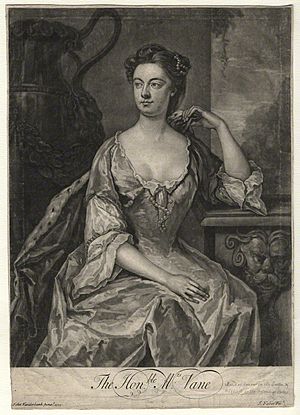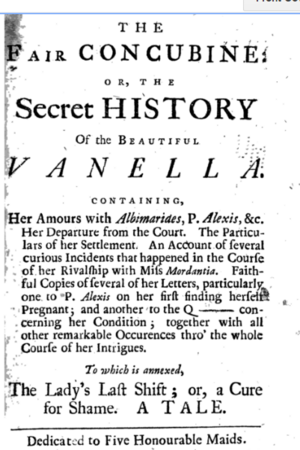Anne Vane facts for kids
Quick facts for kids
Anne Vane
|
|
|---|---|

by John Faber the Younger
|
|
| Born |
Ann Vane
17 September 1710 |
| Died | 1736 |
| Nationality | British |
| Known for | Royal mistress |
| Partner(s) | Frederick, Prince of Wales |
| Relatives | Henry Vane, 1st Earl of Darlington (brother) |
Anne Vane (born September 17, 1710 – died March 27, 1736) was a special assistant, known as a maid of honour, to Caroline of Ansbach. She was also a close companion to Caroline's son, Frederick, Prince of Wales.
Contents
Anne Vane's Early Life
Anne Vane was the first daughter of Gilbert Vane, who was the second Baron Barnard. Her brother, Henry Vane, became an important politician and the first Earl of Darlington. Anne's mother was Mary (born Randyll).
Her Connection to the Royal Family
Anne became a maid of honour to Caroline, Princess of Wales. Caroline later became queen in 1727 when her husband, George II, became king. Anne's mother, Mary, passed away on August 4, 1728.
Life with Prince Frederick
In 1728, Caroline's son, Frederick, came to England. He was made Prince of Wales in 1729. Prince Frederick chose Anne Vane as his special companion. She even helped entertain his guests at her home in Soho Square.
Anne had a son named Cornwell Fitz-Frederick Vane. The name "Fitz-Frederick" meant "child of Frederick." After her son was born, Anne recovered at St. James's Palace.
In 1732, Anne Vane was featured in several books and poems. One book was called The Secret History of the Beautiful Vanella. These writings often talked about her connections with important people.
In 1734, Prince Frederick and Anne were still together. However, in 1735, Prince Frederick became engaged to marry Augusta of Saxe-Gotha. There was a suggestion that Anne should move abroad, but she managed to stay in England. She also kept her yearly payment of £1600.
Later Life and Legacy
In 1735, Anne moved to Bath. Her second child died in London on February 26, 1736. Anne Vane herself passed away a few weeks later in Bath, on March 27, 1736.
There is an engraving of Anne Vane made by John Faber Jr., based on a work by John Vanderbank. Some people believe she was the model for a painting by Hogarth from 1729.
Dr. Johnson mentioned Anne Vane in his famous poem, The Vanity of Human Wishes. He wrote, "Yet Vane could tell what ills from beauty spring." This line refers to Anne.


